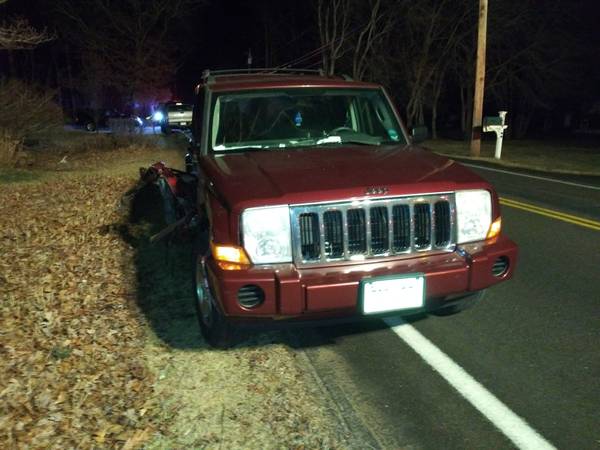Jeep Bodies For Sale: Your Ultimate Guide to Restoration, Customization, and Repair
Jeep Bodies For Sale: Your Ultimate Guide to Restoration, Customization, and Repair /jeeps.truckstrend.com
The iconic silhouette of a Jeep isn’t just a vehicle; it’s a statement, a lifestyle, and for many, a canvas for adventure. Over years of trail abuse, sun exposure, and the inevitable battle with rust, even the toughest Jeep bodies can succumb to the elements. This is where the world of "Jeep Bodies For Sale" becomes invaluable. Far more than just a spare part, purchasing a standalone Jeep body opens up a realm of possibilities for enthusiasts, restorers, and customizers alike. Whether you’re breathing new life into a vintage CJ, building an extreme off-road rig from the ground up, or simply repairing significant damage, understanding the options and processes involved in acquiring a new or used Jeep body is crucial. This comprehensive guide will navigate you through everything you need to know, from types and sources to installation tips and common challenges.
Why Buy a Standalone Jeep Body? The Foundations of Your Project
Jeep Bodies For Sale: Your Ultimate Guide to Restoration, Customization, and Repair
The decision to purchase a standalone Jeep body is often driven by necessity, ambition, or a combination of both. It’s a strategic move that can save time, money, and provide a superior foundation for various projects.
1. Restoration Projects
For owners of classic Jeeps – think CJ-5s, CJ-7s, or early Wranglers (YJ) – rust is an almost unavoidable adversary. Floorboards, rear cross members, and cowl areas are notorious rust traps. A new or rust-free used body can be the most effective, and sometimes only, way to bring a vintage Jeep back to its former glory without endless patch panels and welding. It ensures structural integrity and a clean slate for paint and interior work.
2. Custom Builds and Extreme Off-Road Rigs
When building a highly customized Jeep, especially for serious rock crawling or competitive off-roading, a factory body might not suffice. Enthusiasts often seek lighter materials like fiberglass or aluminum, or stronger, thicker steel aftermarket bodies designed for abuse. Buying a bare body allows for immediate modifications like stretched wheelbases, custom roll cages integrated into the body, or specific fender flares for massive tires, without cutting up a perfectly good complete vehicle.
3. Accident Repair and Damage Replacement
In the unfortunate event of a major accident, the frame of a Jeep might remain sound, but the body could be severely damaged beyond economical repair. Sourcing a replacement body, rather than totaling the vehicle, can be a cost-effective solution to get your beloved Jeep back on the road or trail.
4. Rust Remediation and Prevention

Even if not entirely rusted through, widespread surface rust or pinholes can be a nightmare to chase and treat. A fresh body eliminates these issues, providing a clean, rust-free starting point, significantly extending the lifespan of your vehicle and reducing future maintenance headaches.
5. Cost-Effectiveness
In some cases, particularly for older models, finding a complete, rust-free vehicle can be more expensive than acquiring a good frame and a separate body. This modular approach allows for budget flexibility and often results in a higher-quality finished product, as you can focus resources on individual components.
Types of Jeep Bodies Available: Choosing Your Canvas
The market offers a diverse range of Jeep bodies, each with its own advantages and ideal applications. Understanding these differences is key to making an informed decision.
1. OEM (Original Equipment Manufacturer) Used Bodies
These are bodies salvaged from donor Jeeps, often from accident vehicles where the frame was damaged but the body remained intact, or from parts vehicles.
- Pros: Original fitment, authentic look, potentially lower cost.
- Cons: Condition varies wildly (rust, dents, previous repairs), difficult to verify history, availability depends on salvage market.
- Best For: Budget-conscious restorations, maintaining originality.

2. Aftermarket Steel Bodies
Numerous manufacturers produce brand-new steel replacement bodies, often referred to as "tubs." These are designed to be direct replacements for factory bodies.
- Pros: Brand new (no rust), often made from thicker gauge steel for increased durability, sometimes come with minor improvements (e.g., drain plugs, reinforced areas). Consistent quality.
- Cons: Higher cost than used OEM, requires painting and prep work, shipping can be expensive.
- Best For: Full restorations, custom builds where steel is preferred for strength and ease of repair. Popular brands include Dynacorn, Omix-ADA, and some smaller custom fabricators.
3. Fiberglass Bodies
Fiberglass bodies are molded from composites and offer a distinct set of benefits and drawbacks.
- Pros: Extremely lightweight, completely rust-proof, easier to repair minor dents/cracks (with fiberglass repair kits), can be molded into custom shapes more easily.
- Cons: Less impact-resistant than steel for serious off-roading (can crack under severe stress), can be more challenging to paint to a factory-smooth finish, may require specific body mounts or modifications for fitment.
- Best For: Lightweight race rigs, show vehicles, or Jeeps in high-humidity/salt environments where rust is a primary concern.
4. Aluminum Bodies
While less common and significantly more expensive, aluminum bodies are available from specialist fabricators for ultra-lightweight and rust-proof builds.
- Pros: Minimal weight, absolute rust immunity, high strength-to-weight ratio.
- Cons: Very high cost, specialized welding and repair techniques, limited availability.
- Best For: High-performance builds where weight savings are paramount, competitive applications.
5. Model-Specific Availability
The availability and type of bodies vary significantly by Jeep model:
- CJ-5/7/8 (Scrambler): Excellent aftermarket support for steel and fiberglass tubs due to their age and propensity for rust.
- YJ (Wrangler): Good aftermarket support for steel tubs.
- TJ (Wrangler): Decent aftermarket steel tub support, though less extensive than CJs/YJs.
- JK/JL (Wrangler): Aftermarket bodies are rare and primarily for specialized racing or extreme custom builds, given their newer age and less common need for full body replacement. Most "bodies" for JKs/JLs are typically individual panels.
What to Look For When Buying a Jeep Body: A Critical Inspection Checklist
Once you’ve decided on the type of body, a thorough inspection is paramount, especially for used units.
- Rust: This is the primary concern for steel bodies. Inspect common rust areas: floorboards (driver and passenger side), rear cross member, body mounts, cowl area, lower door sills, and fender wells. Look for bubbling, pinholes, and flaking.
- Dents and Damage: Assess the extent of any dents, creases, or tears. Minor dents are manageable, but significant structural damage or multiple severe dents can be costly to repair.
- Straightness and Squareness: A twisted or bent body will never fit correctly. Check door gaps, windshield frame alignment, and general symmetry.
- Completeness: Does the body come as a bare tub, or does it include fenders, grille, tailgate, windshield frame, and doors? The more complete, the less you’ll need to source separately, but also usually higher cost.
- Previous Repairs: Look for evidence of shoddy patch jobs, excessive body filler, or poorly executed welding.
- Material Integrity: For fiberglass, check for cracks, delamination, or signs of stress fractures. For steel, look for thin spots or areas where rust has compromised the metal.
- Documentation (for Used Bodies): If the body has a VIN (often on the cowl or dash), ensure the seller has a clear bill of sale and can explain its origin. This is crucial for legal registration in some areas.
- Seller/Manufacturer Reputation: Research the seller or aftermarket manufacturer. Read reviews and seek recommendations from the Jeep community.
The Process: Acquiring and Installing Your New Jeep Body
The journey from finding a body to having it mounted on your frame involves several steps.
1. Finding Your Body
- Online Marketplaces: eBay, Craigslist, Facebook Marketplace are popular for used bodies. Use specific search terms like "Jeep CJ7 tub" or "Wrangler YJ body."
- Specialized Forums & Groups: Jeep-specific forums and Facebook groups are excellent resources, often connecting you directly with sellers who understand the product.
- Aftermarket Retailers: Companies like Quadratec, Morris 4×4 Center, and direct manufacturers (Dynacorn, Omix-ADA) are primary sources for new steel and fiberglass tubs.
- Salvage Yards: A diminishing but still viable source for used OEM bodies. Requires patience and thorough inspection.
2. Inspection and Purchase
For used bodies, always inspect in person if possible. If not, request detailed photos and videos, especially of problem areas. Ask for a video call to view the body live. Negotiate price based on condition and completeness. For new bodies, verify shipping terms and warranty.
3. Transportation and Logistics
Jeep bodies are large and cumbersome.
- Shipping: Most aftermarket bodies ship via freight. Get a clear quote, including residential delivery fees or liftgate services. Inspect for shipping damage before signing for delivery.
- Local Pickup: If buying locally, arrange for a flatbed trailer or a large truck. You’ll need at least two strong people (or a forklift/engine hoist) to load and unload.
4. Preparation and Paint
Once acquired, the body requires significant prep work.
- Stripping: Remove all old paint, rust, and grime. Sandblasting is ideal for steel.
- Rust Treatment: For steel bodies, apply a rust converter and a high-quality epoxy primer to prevent future rust.
- Bodywork: Address any remaining dents, dings, or imperfections.
- Sound Deadening/Insulation: Apply sound deadening mats (e.g., Dynamat) and insulation to the interior floors and firewall for a quieter and more comfortable ride.
- Paint: A high-quality paint job is crucial for durability and aesthetics. This is often the most expensive part of the prep. Consider a professional paint shop.
5. Installation
This is where your project comes to life.
- Frame Preparation: Ensure your frame is clean, rust-free, and painted. Verify all body mounts are present and in good condition.
- Lifting: Use an engine hoist or multiple strong individuals to carefully lift the body onto the frame.
- Alignment: Carefully align the body with the frame, ensuring all body mounts line up.
- Mounting: Secure the body to the frame using new body mount bolts and bushings. Do not overtighten initially; allow for minor adjustments.
- Reassembly: Reinstall all components: wiring harness, brake lines, fuel lines, steering column, dashboard, seats, roll bar, doors, fenders, grille, and windshield frame. This is a meticulous process that requires patience and often a good service manual.
Challenges and Solutions
- Hidden Rust/Damage: Solution: Thorough pre-purchase inspection. For new bodies, unbox and inspect immediately upon arrival.
- Fitment Issues: Solution: Minor discrepancies are common, especially with aftermarket parts. Body shims can help with alignment. For more significant issues, minor fabrication or professional help might be needed.
- Cost Overruns: Solution: Create a detailed budget for the body, shipping, prep, paint, and all associated hardware. Factor in a 10-15% contingency.
- Shipping Damage: Solution: Inspect freight deliveries before signing. If damage is present, note it on the bill of lading and photograph everything. File a claim immediately.
- Lack of Tools/Expertise: Solution: Don’t be afraid to ask for help from experienced friends or hire professionals for specific tasks like paint or major welding.
Tips for a Successful Jeep Body Project
- Plan Meticulously: Outline every step, from sourcing to final bolt.
- Set a Realistic Budget: Factor in all costs, including consumables, tools, and unexpected issues.
- Do Your Research: Understand the specifics of your Jeep model and the aftermarket options.
- Don’t Rush: Quality work takes time. Patience will prevent costly mistakes.
- Document Everything: Take photos before, during, and after. This helps with reassembly and provides a record of your work.
- Join the Community: Online forums, local Jeep clubs, and social media groups are invaluable resources for advice, parts, and moral support.
Jeep Bodies For Sale: Estimated Price Guide
Please note: Prices are highly variable based on condition (for used), manufacturer, completeness, and current market demand. These are estimates and do not include shipping, paint, or installation costs.
| Jeep Model (Year Range) | Body Type | Condition/Completeness | Estimated Price Range (USD) | Notes/Considerations |
|---|---|---|---|---|
| CJ-5 (1955-1983) | Used OEM | Bare Tub (Rust/Dents) | $500 – $1,500 | Expect significant rust repair; best for donor projects. |
| Aftermarket Steel | Bare Tub (New) | $3,000 – $5,500 | Requires paint, often thicker gauge steel. | |
| Fiberglass | Bare Tub (New) | $2,500 – $4,500 | Lightweight, rust-proof; may require specific mounting. | |
| CJ-7 (1976-1986) | Used OEM | Bare Tub (Fair) | $1,000 – $2,500 | Minor rust likely, good starting point for restoration. |
| Aftermarket Steel | Bare Tub (New) | $3,500 – $6,000 | Most popular aftermarket body type for CJs. | |
| Fiberglass | Bare Tub (New) | $3,000 – $5,000 | Ideal for custom or lightweight builds. | |
| YJ Wrangler (1987-1995) | Used OEM | Bare Tub (Fair) | $800 – $2,000 | Rust common around rear cross member and floorboards. |
| Aftermarket Steel | Bare Tub (New) | $3,000 – $5,000 | Direct replacement, good quality. | |
| TJ Wrangler (1997-2006) | Used OEM | Bare Tub (Good) | $1,500 – $3,500 | Less common for full replacement, often individual panels. |
| Aftermarket Steel | Bare Tub (New) | $4,000 – $6,500 | Limited availability compared to CJs/YJs. | |
| JK/JL Wrangler (2007+) | Used OEM | Individual Panels | $200 – $1,500 (per panel) | Full tubs rarely available/needed; focus on specific damaged sections. |
| Custom/Race | Bare Tub (New, Steel/Alu) | $8,000 – $20,000+ | Highly specialized, custom-fabricated for specific builds. |
Frequently Asked Questions (FAQ)
Q1: Is it legal to replace my Jeep body?
A1: Yes, replacing a vehicle body is generally legal. However, if the new body comes with a VIN (e.g., a used OEM body), you must ensure proper documentation and potentially notify your local DMV or equivalent authority. In most cases, the vehicle’s identity is tied to the frame’s VIN, not the body’s. Always check local regulations.
Q2: How much does a new Jeep body cost?
A2: As per the table above, prices for a new aftermarket steel body can range from $3,000 to $6,500 for a bare tub, depending on the model. Fiberglass bodies are often in a similar range or slightly less. This does not include shipping, paint, or installation.
Q3: Can I install a Jeep body myself?
A3: Yes, it is a common DIY project for experienced mechanics and enthusiasts. However, it requires proper tools (engine hoist or multiple strong helpers), a clean workspace, mechanical aptitude, and a lot of patience. If you’re unsure, consider hiring a professional for critical steps like lifting and final alignment.
Q4: What’s better: steel or fiberglass?
A4: It depends on your priorities.
- Steel: Stronger for off-road impacts, easier to repair with traditional bodywork, authentic feel. Prone to rust.
- Fiberglass: Lighter, rust-proof, often more affordable. Can crack under severe impact, requires specific repair techniques, and may flex more.
Choose steel for hardcore off-roading and authenticity, fiberglass for weight savings and rust immunity.
Q5: Where can I find Jeep bodies for sale?
A5: Key sources include aftermarket retailers (e.g., Quadratec, Morris 4×4 Center, Omix-ADA), online marketplaces (eBay, Craigslist, Facebook Marketplace), specialized Jeep forums, and salvage yards.
Q6: Do Jeep bodies come with VINs?
A6: Only used OEM bodies will typically have a VIN stamped or riveted to them. New aftermarket bodies do not come with VINs, as they are considered replacement parts. If you’re using a used OEM body with a VIN, ensure you have a clear bill of sale from the seller to avoid any legal complications.
Q7: What about body mounts?
A7: Aftermarket tubs typically require you to reuse your existing body mounts or purchase new aftermarket body mount kits. These kits usually include new rubber bushings and hardware to ensure proper cushioning and secure attachment to the frame.
Conclusion
The journey of acquiring and installing a new or replacement Jeep body is a significant undertaking, but one that offers immense rewards. Whether you’re resurrecting a classic, building a custom off-road monster, or simply rectifying extensive damage, purchasing a standalone body provides a robust and often superior foundation for your project. By understanding the different types available, conducting thorough inspections, planning your logistics, and preparing for the challenges, you can embark on this exciting endeavor with confidence. The result will be a Jeep that not only looks fantastic but is structurally sound and ready for countless more adventures, embodying the spirit of rugged individualism that defines the Jeep legacy.
![]()





